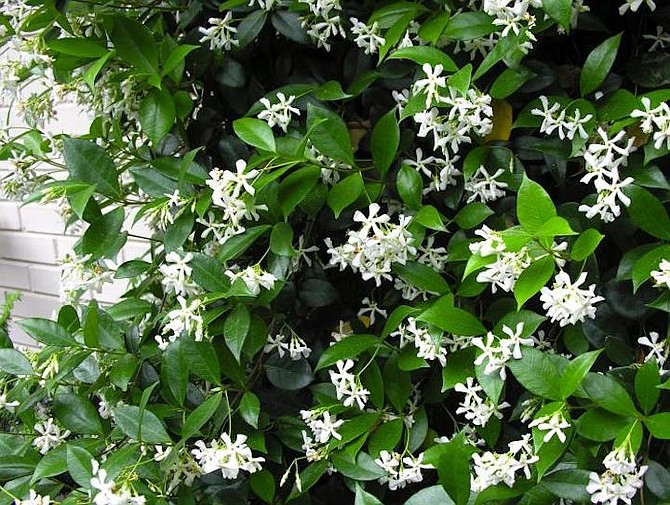 Facebook
Facebook
 X
X
 Instagram
Instagram
 TikTok
TikTok
 Youtube
Youtube

Star Jasmine's Sweet Perfume, exuded from clusters of small, white flowers, will continue to scent San Diego's spring breezes until sometime in June. Not a true jasmine, or Jasminum, star jasmine belongs to the genus Trachelospermum. In both public and private spaces, it has been widely planted as an ornamental ground cover and as a trellised vine.

The Annual Green-to-Golden Transition of San Diego's wild grasslands typically takes place in April. North-facing hillsides and canyon slopes retain the green color longer, as they are less exposed to drying sunshine. Locally, most of the wild grasses are naturalized (non-native) annuals, the seeds of which were introduced along with hay and other grains brought in by the Spaniards during the 18th and 19th centuries. Some of the mountain meadows have remnants of native grasses, which remain more or less green almost the year round. These rare native grasslands can be found in certain parts of Cuyamaca Rancho State Park and more widely distributed at the Santa Rosa Plateau Ecological Reserve in the Santa Ana Mountains west of Temecula.
The Arch of Spring. On Friday, April 23, as night descends, look high in the west for Pollux and Castor lined up almost horizontally depending on your latitude. These two stars, the heads of the Gemini twins, form the top of the enormous Arch of Spring. To their lower left is Procyon, the left end of the Arch. Farther to their lower right is the other end, formed by Menkalinan (Beta Aurigae) and then brilliant Capella.
This spring the Arch has an intruder: little Mars. Tonight you'll find Mars the same distance lower right from the Castor-Pollux pair as it is lower left from Capella. The whole array sinks in the west through the evening.
Modern skywatchers are not alone in seeing the Arch of Spring as one big asterism. Extend it down past Procyon to add Sirius, and you've got the Hawai‘ian Canoe-Bailer of Makali‘i. Looks big enough to bail the ocean.
The above comes from the Outdoors listings in the Reader compiled by Jerry Schad, author of Afoot & Afield in San Diego County. Schad died in 2011. Planet information from SkyandTelescope.org.


Star Jasmine's Sweet Perfume, exuded from clusters of small, white flowers, will continue to scent San Diego's spring breezes until sometime in June. Not a true jasmine, or Jasminum, star jasmine belongs to the genus Trachelospermum. In both public and private spaces, it has been widely planted as an ornamental ground cover and as a trellised vine.

The Annual Green-to-Golden Transition of San Diego's wild grasslands typically takes place in April. North-facing hillsides and canyon slopes retain the green color longer, as they are less exposed to drying sunshine. Locally, most of the wild grasses are naturalized (non-native) annuals, the seeds of which were introduced along with hay and other grains brought in by the Spaniards during the 18th and 19th centuries. Some of the mountain meadows have remnants of native grasses, which remain more or less green almost the year round. These rare native grasslands can be found in certain parts of Cuyamaca Rancho State Park and more widely distributed at the Santa Rosa Plateau Ecological Reserve in the Santa Ana Mountains west of Temecula.
The Arch of Spring. On Friday, April 23, as night descends, look high in the west for Pollux and Castor lined up almost horizontally depending on your latitude. These two stars, the heads of the Gemini twins, form the top of the enormous Arch of Spring. To their lower left is Procyon, the left end of the Arch. Farther to their lower right is the other end, formed by Menkalinan (Beta Aurigae) and then brilliant Capella.
This spring the Arch has an intruder: little Mars. Tonight you'll find Mars the same distance lower right from the Castor-Pollux pair as it is lower left from Capella. The whole array sinks in the west through the evening.
Modern skywatchers are not alone in seeing the Arch of Spring as one big asterism. Extend it down past Procyon to add Sirius, and you've got the Hawai‘ian Canoe-Bailer of Makali‘i. Looks big enough to bail the ocean.
The above comes from the Outdoors listings in the Reader compiled by Jerry Schad, author of Afoot & Afield in San Diego County. Schad died in 2011. Planet information from SkyandTelescope.org.
Comments